Paolo Corsetti, IK3GER is an Italian Ham who lives in Mestre which is part of the town of Venice. Paolo has just released the 2018 “Calling Antarctica Award” to be issued at the end of the Antarctic Activity Week.
Paolo wrote: Every year, in the month of February, a special activity called “Antarctic Activity Week” takes place. This year, the 15th AAW will be held from February 17 to 25.
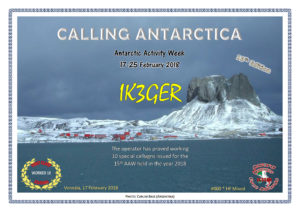 All WAP (Worldwide Antarctic Program) stations have a special WAP reference number that will be given during the QSO.
All WAP (Worldwide Antarctic Program) stations have a special WAP reference number that will be given during the QSO.
The diploma is issued in 2 classes to OM/SWL:
a) “Basic” for at least 5 QSO/HRD with different calls,
b) “First Class” for 10 or more QSO/HRD with different calls.
Only QSO/HRD made between February 17th and 25th, 2018 are valid for this diploma. QSL cards are not needed. Endorsement is available for mode only (CW, SSB, Mixed, various digimodes) The Award is free, and will be sent to the applicants via email as a PDF (JPG on request). WAP reference of the station worked is mandatory in your application
Send your application via email or ask for more information to the Award Manager IK3GER at: corsetti.paolo@libero.it
TNX Paolo, IK3GER (https://www.ik3ger.it)

 It’s now time to book the 15th AAW, getting your special call, your WAP reference number and jump into the unique International Ham event to promote Antarctica … join in and enjoy it!
It’s now time to book the 15th AAW, getting your special call, your WAP reference number and jump into the unique International Ham event to promote Antarctica … join in and enjoy it! February 25nd. Someone may ask the reason of why this edition is two days longer than the past years; well, several participants did ask the possibility to have 2 weekends instead of 1 … so this year will be a test, if 2 more days are felt too long, next edition will return back to 7 days activity.
February 25nd. Someone may ask the reason of why this edition is two days longer than the past years; well, several participants did ask the possibility to have 2 weekends instead of 1 … so this year will be a test, if 2 more days are felt too long, next edition will return back to 7 days activity.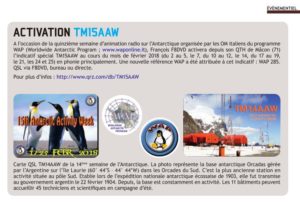 the January issue of REF bulletin.
the January issue of REF bulletin. Pedro LU1JHF, informs WAP that Juan C. Benavente (LU8DBS) is actually active from Base T.te Benjamin Matienzo 64° 58’ 34” South, 60° 04’ 05” West, as LU1ZAB. Check daily on 7,118 MHz. from 23:00 (UTC) and sometimes from 02: 00 (UTC), in SSB. Juan should be there till February 2018
Pedro LU1JHF, informs WAP that Juan C. Benavente (LU8DBS) is actually active from Base T.te Benjamin Matienzo 64° 58’ 34” South, 60° 04’ 05” West, as LU1ZAB. Check daily on 7,118 MHz. from 23:00 (UTC) and sometimes from 02: 00 (UTC), in SSB. Juan should be there till February 2018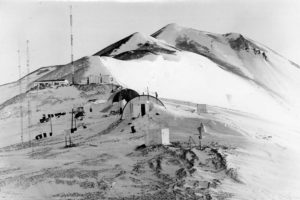
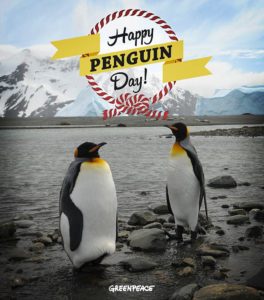 20 January is a day dedicated to the world of penguins: did you know that they are aquatic animals and that their survival depends on the health of the oceans? Protecting their ecosystem is the only way to help them.
20 January is a day dedicated to the world of penguins: did you know that they are aquatic animals and that their survival depends on the health of the oceans? Protecting their ecosystem is the only way to help them.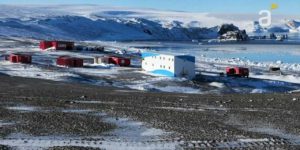 with about 5 tons of frozen food and 226,000 liters of Antarctic gas oil.
with about 5 tons of frozen food and 226,000 liters of Antarctic gas oil. Russian Antarctic Bases Award (RABA) managed by Russian Robinson Club is given for QSO/SWL with radio stations situated on the territory of the ex USSR and Russian Antarctic Bases. Certificates are issued in three different classes with Plaque – Honour Roll and the last born “Plaque.of Excellence”.
Russian Antarctic Bases Award (RABA) managed by Russian Robinson Club is given for QSO/SWL with radio stations situated on the territory of the ex USSR and Russian Antarctic Bases. Certificates are issued in three different classes with Plaque – Honour Roll and the last born “Plaque.of Excellence”. The station will be set on Inexpressible Island in Terra Nova Bay in the Ross Sea. After it is built, the year-round base will be used to investigate the land, sea, atmosphere, and glaciers in the Antarctic. Chinese icebreaker ‘Xuelong is bound for Antarctica with construction materials in tow to build the country’s fifth scientific research station on the continent.
The station will be set on Inexpressible Island in Terra Nova Bay in the Ross Sea. After it is built, the year-round base will be used to investigate the land, sea, atmosphere, and glaciers in the Antarctic. Chinese icebreaker ‘Xuelong is bound for Antarctica with construction materials in tow to build the country’s fifth scientific research station on the continent. Despite its frigid solitude, at several sites in the Antarctic nations from around the world have joined forces in the name of research: the Argentinian Carlini Station ( ex- Estacion Cientifica T.te Jubany) WAP ARG-20 on King George Island, one of the South Shetland Islands, is a prime example:Different nations, all under one roof,
Despite its frigid solitude, at several sites in the Antarctic nations from around the world have joined forces in the name of research: the Argentinian Carlini Station ( ex- Estacion Cientifica T.te Jubany) WAP ARG-20 on King George Island, one of the South Shetland Islands, is a prime example:Different nations, all under one roof,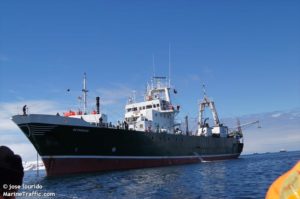 DAP, the Chilean company that owns and operates the M/V Betanzos and the helicopters with a cost of almost 1/2 million U.S. dollars.
DAP, the Chilean company that owns and operates the M/V Betanzos and the helicopters with a cost of almost 1/2 million U.S. dollars.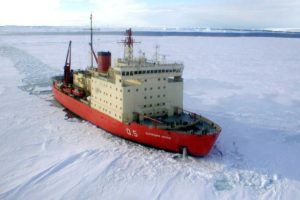 The Argentinean Antarctic Summer Campaign 2017/2018, formally started on last December 18, 2017, when the ship “Estrecho de San Carlos” and the naval transport “Canal de Beagle” sailed from the port of Buenos Aires.
The Argentinean Antarctic Summer Campaign 2017/2018, formally started on last December 18, 2017, when the ship “Estrecho de San Carlos” and the naval transport “Canal de Beagle” sailed from the port of Buenos Aires. Kerry Peters was an elementary school teacher when he was offered retirement . He didn’t really had any of those “What will I do with myself now?” anxieties. He took retirement when it was offered, because he was already looking forward to what came next: exploring the polar regions.
Kerry Peters was an elementary school teacher when he was offered retirement . He didn’t really had any of those “What will I do with myself now?” anxieties. He took retirement when it was offered, because he was already looking forward to what came next: exploring the polar regions.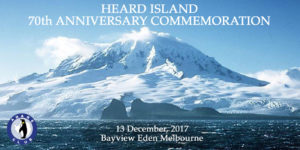 Lee Moyle VK3GK is operating VI7ØHI, a Special Callsign issued to Commemorate the first ANARE Expedition to Heard Island in December 1947.
Lee Moyle VK3GK is operating VI7ØHI, a Special Callsign issued to Commemorate the first ANARE Expedition to Heard Island in December 1947. dog run, and a large tractor. These men carried out meteorological, geophysical, upper atmosphere, and biological research, a program that continued for 7 years until the base was abandoned. Since 1969, ANARE has visited Heard Island every few years, mostly to check up on the ruins of the original encampment.
dog run, and a large tractor. These men carried out meteorological, geophysical, upper atmosphere, and biological research, a program that continued for 7 years until the base was abandoned. Since 1969, ANARE has visited Heard Island every few years, mostly to check up on the ruins of the original encampment.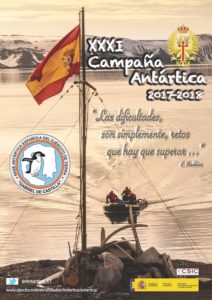 230 people will participate to the XXXI Spanish Antarctic Campaign, carry out 16 research projects, two of them aboard the Hespérides Oceanographic Research Ship, which will also support five international projects of Germany , Belgium, Colombia and Portugal. In addition, in this campaign will also be released a warehouse module at the Gabriel de Castilla Antarctic Base, (WAP ESP-Ø2) managed by the Spanish Army.
230 people will participate to the XXXI Spanish Antarctic Campaign, carry out 16 research projects, two of them aboard the Hespérides Oceanographic Research Ship, which will also support five international projects of Germany , Belgium, Colombia and Portugal. In addition, in this campaign will also be released a warehouse module at the Gabriel de Castilla Antarctic Base, (WAP ESP-Ø2) managed by the Spanish Army.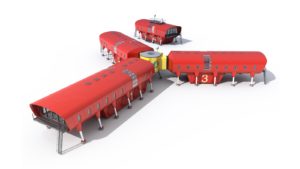
 The new buildings, set in the shape of a clover or tripod, has 2,000 square meters of living space, 600 meters of laboratories, 1,500 square meters of storage, and capacity for 52 people per module.
The new buildings, set in the shape of a clover or tripod, has 2,000 square meters of living space, 600 meters of laboratories, 1,500 square meters of storage, and capacity for 52 people per module.